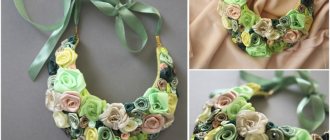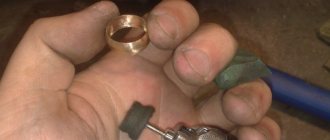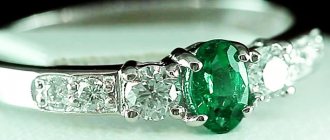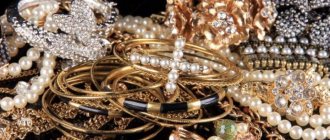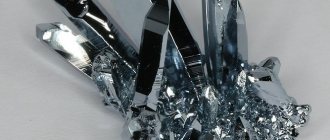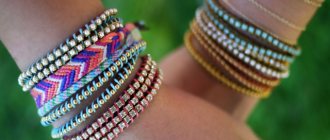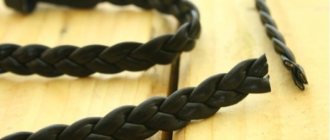A fashionable and elegant accessory to any look will be homemade jewelry made from wire and all kinds of large beads. They are easy to create, but at the same time they look original and expensive. It is important to think through all the details ahead of time and purchase the necessary materials and tools.
Of course, the most important thing is to purchase wire. The wire is easy to use, but more importantly, it is flexible, discreet and convenient.
Wire products can be of different colors and types; they can be suitable for both women and men.
Crafts for Beginners
In order to understand how to make wire jewelry, you need to have basic knowledge of processing the material and using tools. Any product is created using the winding method.
The raw materials used are brass, copper, aluminum or silver wire.
The base is created from thick raw materials, and the ornament is created from thinner ones. It is allowed to place multi-colored stones, beads or beads inside the craft.
Tools and materials
In order to make a wearable product from wire yourself, you don’t have to look for complex devices. All you may need are the usual pliers, a hammer, round nose pliers and a small vice.
But it’s worth considering that when working with wire, it’s best to use specialized pliers; they have a smooth inner surface and can’t damage the material.
Special devices also include pliers with nylon removable pads; they are used to straighten an unsuccessfully twisted wire spiral.
When choosing a working material, thick electrical wire, which can be purchased at all electrical goods stores, deserves more attention.
Simple ring with bead
Weaving wire jewelry involves using two types of pliers. Some are chosen with curved tips, while others are chosen with regular ones.
It is also necessary to prepare the wire and the bead itself. The latter can be bought or found in an old jewelry box.
First of all, a small piece of wire is cut off. Its length should be approximately 15 cm. The wire is wrapped around a cylindrical object, the diameter of which is equal to the thickness of a finger.
Even an ordinary candle can be used as a form. The bead is attached inside the ring and secured with 4-5 turns around.
In this case, the wire can be threaded into it if there is a special hole. A coil over its surface allows you to securely fix an object on a wire.
The remaining wire is cut off, having previously measured the required length. It is recommended to leave 1-1.5 cm as a margin so that the ring can be removed from the finger.
Tips for use
If the source material is too hard and does not bend at all, it must be softened by heating it over a stove. At the same time, be sure to work with gloves, otherwise you can easily seriously injure your hands.
Wires with a diameter of 1 mm, 0.6 mm and 0.2 mm are most often used in jewelry.
It is best to use wire with a diameter of 1 mm in order to better fill the gap between the beads, if used.
In addition, the thicker the wire, the longer it will last. And if the wire is thin and the decoration has beads, then the accessory will not last long, because the wire, when moving freely inside the beads, will rub against their edges and eventually become too thin and simply break.
The lighting should be good; you should not work in the dark or twilight.
Bracelets with beads
You can make your own wedding decorations from wire without leaving your home. You only need a few simple materials and tools:
- pliers;
- silver wire;
- beads of different sizes and colors.
The weaving process begins by using pliers to create the first loop. After 2-3 cm a similar curl is created. Then beads are put into the resulting loops. They are fixed by simply twisting the wire clockwise.
A secure fastening involves two turns around the bead. The remaining free ends, after measuring the size, are connected together. The fastening can be a standard fastener.
Choosing jewelry wire for jewelry
To create jewelry, several types of wire are selected. The price of the decoration depends on the choice of material:
- to create an exquisite accessory, use silver wire of different hardness;
- for the manufacture of loops and bracelets, memory wires made of black steel are used;
- Expensive, exclusive rings are made from cast gold;
- for greater expressiveness, a French wire spiral made of pure silver is used in the work;
- inexpensive options - wires made of aluminum, copper , niobium, with which people begin to master the technique of wireworking;
- tiger tail - stainless steel cord with nylon winding.
Aluminum is the most malleable material
For weaving small chains, the base of rings, use material with a diameter of no more than 0.4 mm, for attaching beads, cabochons, untreated stones, thick winding - 0.3 mm, hooks, pins, ring earrings made of wire, pendants made of glass beads are made from the material larger caliber (0.8−1 mm).
Beautiful accessories for the home: a frame for a lampshade, napkin rings are woven from thick wire (1.3 - 1.6 mm) . The base of hairpins, combs, barrettes, and other fashionable hair decorations is made especially durable, using wires with a cross-section of 1.7-2 mm.
Beginners create their first products in the wireworking technique from technical copper; the composition of the cable cores is regulated by GOST, so there are no harmful impurities in copper wires, or they are contained in minimal quantities. Silver jewelry is made by professionals.
Is wire feminine?
Decorating hair with wire with your own hands, creating unusually beautiful pendants, earrings, rings and bracelets are suitable for both men and women. But the question often arises: will such rough material look feminine?
Experienced craft makers claim that wire is one of the most common and beautiful materials for creating jewelry. These raw materials make beautiful and delicate products. The main thing is that they are created by experienced hands.
Modern technologies are being used to finally dispel the myth that wire is not feminine. Thanks to special equipment, it is possible to produce wire of any diameter.
Thin and flexible wire allows you to create the most beautiful and delicate weaving. After all, these products are used by jewelry manufacturers all over the world.
Jewelry wire made from silver is popular. Jewelry was first used to make it during the reign of the pharaohs in Ancient Egypt.
NOTE!
Decorating bottles - beautiful and original ideas for decorating bottles with your own hands (120 photos and videos)- Hair jewelry: the best ideas for choosing hair jewelry and tips for choosing a design (105 photos)
- Sushi Master - Japanese restaurant in Chita
The hairstyles of rich and noble women were decorated only with this product. Already at that time, they learned how to create thin plates that were pierced at the ends and fastened with threads on the necks and arms.
Scan: precious lace technology
At a time when there was no large-scale jewelry production, when jewelry was considered a luxury, filigree arose in Rus'. The unique technique of artistic metal processing has been passed down from generation to generation, preserving the ancient secrets of weaving precious lace.
Filigree and filigree
Often people who are far from jewelry production have a question: what is the difference between filigree and filigree?
The term “filigree” has Latin roots and comes from two words filum - thread and granum - grain. In our country, this decorative method of metal processing has acquired not only a unique Russian flavor, but also another name - filigree (from the Old Russian “skati” - to twist, twist). In jewelry, both concepts mean a special technique for making products by soldering thin wire from precious metals into a pattern. Often filigree jewelry is complemented with enamel, stones and grains - small gold or silver balls.
From the history of filigree
In Rus', filigree technology has a long history. Back in the 9th-10th centuries, grain began to be used to decorate jewelry. Later, in the 12th-16th centuries, in addition to brazed filigree, openwork filigree began to be used, which was supplemented with stones, enamel and even wood. The most ancient filigree creations of this period - "Monomakh's Cap" and "Ryazan Barms" - are now kept in the Armory Chamber.
Russian filigree flourished in the 18th-19th centuries, when it acquired the status of jewelry. At this time, not only small objects (vases, boxes, cigarette cases), but also voluminous decorative panels were created using the filigree technique. The production of filigree items is acquiring an industrial scale: jewelry factories produce dishes, church utensils and various accessories. And yet, each such decoration was created by hand.
In the 20th century, Art Nouveau style makes new demands on jewelry fashion. Other methods of decorating jewelry are being developed, and some manufacturing processes are being mechanized. However, with all the diversity of jewelry production technologies, the methods of making scanned items remain traditional.
Types of filigree
Depending on the chosen technique, there are several types of filigree.
When using soldered filigree, the resulting pattern is applied to a metal base.
Openwork filigree is a method of making filigree in which decorative elements are soldered together without a background, forming metal lace.
Three-dimensional filigree is used to create objects such as vases, goblets, boxes, animal figures, etc. These products are made from separate parts, which are then combined into a single composition.
How filigree lace is woven
To create scanned masterpieces that look like frosty lace, you don't need a lot of tools or high-tech equipment. Much more important here is the skill and talent of a specialist who performs truly jewelry work.
Wire twisted into elements of a scanned product
Wire Twisting
Pre-flared wire is sorted by thickness, twisted or left smooth, depending on the design idea.
Layout of elements according to the drawing
The filigree is collected exclusively by hand. Interestingly, incredibly delicate filigree lace is made up of just a few traditional elements, the most common of which are a ring, a gear, a curl, a clove, a burr and a grass.
The most common filigree elements
The pattern drawn on paper is made of metal wire and glued to the sketch. The elements must be absolutely identical, which is why a necessary condition for the work is to create a full-size sketch of the product.
Soldering the scanned pattern
Next, the glued parts are soldered together, forming larger elements. Under the influence of the flame, the paper burns, but the metal pattern remains. This is an equally painstaking process, since if the temperature is too long or too strong, not only the paper will be destroyed, but also the thin scanned lace.
To give the metal a special shine, the parts are dipped into a special chemical solution, polished and only then joined together.
Scan in modern times
Nowadays, scanned items are considered a masterpiece of jewelry art and an attribute of high fashion.
At the beginning of 2014, the fashion world was shocked by the winter collection of accessories from Dolce&Gabbana. One of the designer finds was bags and shoes decorated with gold filigree. In the “filigree” accessories studded with stones, lace sounded in a new way, while preserving the richness and luxury of ancient jewelry techniques. This collection became a landmark event, raising filigree to the rank of high fashion.
Collection from Dolce&Gabbana with filigree motifs
The perfection of natural forms inspired the craftsmen of the SOKOLOV company to create silver filigree falcons, which became symbols of the brand. Incredibly beautiful patterns seem miraculous and amaze with their sophistication and weightlessness. The embodiment of the beauty and graceful lightness of the freedom-loving bird became possible thanks to a combination of ancient filigree-making secrets and the unsurpassed skill of jewelers.
Falcon made of filigree silver
Falcon made of filigree silver
Elements of a filigree product
Scan in close-up
Scan details
General recommendations
With the advent of the Internet, many options for creating original wire jewelry have appeared.
Master classes offer a wide variety of weaving options that will allow you to create truly grandiose crafts.
But to use this skill correctly, you need to know a few simple rules.
- Firstly, the surface of the wire is varnished to prevent oxidation.
- Secondly, after heating the wire, apply a small amount of regular baby cream to it, and then wash it off with water.
- Thirdly, the use of patina is allowed, although this option is not used by all craftsmen.
- Fourthly, a sketch of the future jewelry must be created.
Rating of the most expensive jewelry metals
For some reason, it has become such a thing in the jewelry world that everyone considers platinum to be the most expensive precious metal, but is this really so? There are many publications that like to compile ratings: the most expensive Christmas tree decorations; the most expensive hats in the world... This time we propose to evaluate what the most expensive precious metals used in the jewelry industry actually are. We especially emphasize that the conversation will be about jewelry metals; we will not touch upon just expensive and rare metals on the planet.
1. Cost $225.1 per 1 gram . So, we give first place to the jewelry metal “ Rhodium ”. In principle, those people who consider platinum the most expensive metal are right, because rhodium also belongs to the platinum group, but the compositions of these precious materials are slightly different. Rhodium has a silvery-white color and is used as a finishing material; for example, modern jewelry-making techniques make it possible to coat white gold and silver items with a thin layer of rhodium.
So what is rhodium used for if jewelry is not made from the metal itself? First of all, rhodium has high strength, it is resistant to corrosion, and also has reflective properties. That is why, in order for your jewelry to last for more than one generation, it is necessary to apply a thin layer of rhodium on top. This metal is also added as an alloying mixture to palladium and platinum. For reference, alloying means strengthening.
Jewelry with a layer of rhodium is wear-resistant, scratch-resistant, has a bright shine, does not darken, and rhodium is hypoallergenic. For example, if your skin is sensitive to silver or gold, then the rhodium layer will prevent an allergic reaction from developing. Rhodium is a very rare metal, but not radioactive; only a few tons are mined per year.
2. Cost $69.1 per 1 gram . We rightfully give second place to platinum . At first, platinum was not classified as a separate group, but was considered white gold, and the most interesting thing is that counterfeiters were the first to use it to replace expensive silver and gold. At the time, this seemed like the best option, but in the middle of the 18th century, platinum received its own group and became an independent metal.
Platinum’s properties are quite ambiguous: chemically, this metal is recognized as the most stable. Platinum does not oxidize, retains its color when exposed to high temperatures and cooling, and acids cannot affect it. Platinum has a high weight and density, which makes it durable, it does not wear out and is a good support for precious stones. That is why many famous diamonds are set in this expensive metal, for example, the Koh-i-Noor diamond.
However, despite the high cost, jewelry is still created from platinum, this is due to the high ductility of the material. From one gram of platinum you can create a very thin but strong wire about 2 kilometers long. This is why jewelers love and use platinum, not only does it have a beautiful white shiny color, but it can also be used to create flexible jewelry.
3. Cost $29.7 per 1 gram. Bronze goes to another common jewelry metal - gold, which seems to be intended by nature for use in the jewelry industry. It occurs in its pure form, unlike platinum, is resistant to corrosion, ductile, compact and homogeneous. In addition, gold is considered the most malleable metal, much like the situation with platinum; from one gram you can forge a wire 2.4 km long.
But in terms of chemical strength, gold is still inferior to the platinum group: rhodium and platinum. However, if you are not going to dip your jewelry in sulfuric acid or throw it into a melting furnace, then jewelry made of gold of any standard and type: white, red, yellow will wonderfully add to your home jewelry collection.
4. Cost $16.5 per gram . The fourth place goes to iridium . Many will be surprised to see this metal in our rating, because no one has heard of iridium being used to create jewelry. However, this is true, the same situation arises here as with rhodium; jewelry is not made from iridium itself, but this metal is added to platinum to make it almost three times harder.
According to its properties, iridium is a very heavy, durable and hard metal, although brittle. Adding just 10% iridium to platinum makes the jewelry virtually wear-free. Therefore, this metal is widely used by jewelers all over the world, in addition, iridium-platinum products are very, very beautiful.
5. Cost $14.7 per 1 gram . With a bit of a twist, we still add ruthenium . This metal is named after Russia, because Ruthenia means Russia in Late Latin. Rhodium is also a platinum group metal, but the most fragile of all of the above. But jewelers still occasionally add it to platinum, thereby giving ruthenium an honorable fifth place.
6. Cost $14.5 per 1 gram . Palladium , which has recently literally conquered the jewelry industry due to its properties: it is the most ductile of the platinum group metals, light, flexible and fusible. Jewelers successfully use all these qualities to create stunning jewelry masterpieces, because such flexibility of palladium allows you to create completely crazy fantasies and shapes of precious items. Do not forget that palladium is the cheapest of the platinum group, but it also has anti-corrosion properties and does not tarnish, so it is good to add to other precious metals.
7. Cost $0.6 per 1 gram . So, we got to probably the most common precious metal - silver . Note that in terms of cost it is the cheapest, but also the most used. The main advantage of silver is that, like gold, it occurs in its native form, which means it does not have to be smelted from ore.
In fact, silver is far superior to platinum in its qualities; it has a noble shine that is brighter and more distinct than other precious metals. In addition, rhodium-plated silver will retain its color for a long time and will not darken. Silver goes well with any precious or semi-precious stone and looks great on both men and women.
8. Cost 1,750 rubles. per gram . Since we are talking about jewelry metals, it makes sense to briefly talk about other jewelry alloys that can hardly be called precious, but they are still used to create jewelry. So, titanium , this metal is now conquering the heights of jewelry and more and more jewelry companies are using it in their work. We wrote a separate article about titanium, so we will not dwell in detail on the advantages of this material.
9. Cost 1,750 rubles per gram . Along with titanium is tungsten , which is very hard, wear-resistant and heavy. On the one hand, it is not expensive, but in terms of technology, tungsten is very difficult to work with. Tungsten is considered a masculine metal and is used in the jewelry market to create distinctly masculine jewelry.
10. Cost 1.5 rubles per gram . Cupronickel , which is essentially an alloy of copper and nickel. Quite often, jewelers use it to create rings, bracelets and earrings. However, cupronickel is most often used to work on cutlery and accessories.
Please note that we described the cost of the last three metals in rubles, because converting into dollar equivalent simply does not make sense, there will be too many zeros after the decimal point. We have listed almost all modern jewelry metals, at least the most used ones. As can be seen from the article, each precious metal has different properties, but now, by creating various alloys, you can play with the quality of jewelry and its effect on the body. Therefore, now, if you hear that silver is darker from sweat, and gold cannot be worn in the bathhouse, just ask if your products are plated with the same rhodium.
